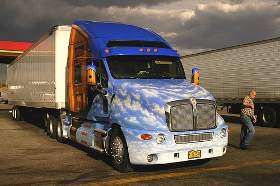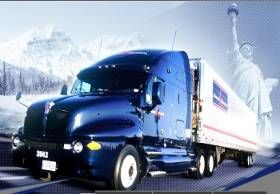New! High Road 2.0! We have a new version of this program. You can find it here: High Road 2.0
2.9 Driving in Fog
Do not drive in fog if at all possible. Pull off the road into a rest area or truck stop until visibility is better. If you must drive:
- Obey all fog-related warning signs.
- Slow before you enter fog.
- Turn on all your lights (headlights should be on low-beams).
- Be prepared for emergency stops
2.10 Driving in Winter
Make sure your vehicle is ready before driving in winter weather by making regular pre-trip inspections.
Coolant and Antifreeze:
Make sure the cooling system is full and there is enough antifreeze in the system to protect against freezing. This can be checked with a special coolant tester.
Defrosting and heating equipment:
Make sure the defrosters work. Make sure the heater is working and that you know how to operate it. If you use other heaters and expect to need them (e.g., mirror heaters, battery box heaters, fuel tank heaters), check their operation.

Wipers and Washers:
Make sure the windshield wiper blades are in good condition. Make sure the wiper blades press against the window hard enough to wipe the windshield clean. Otherwise they may not sweep off snow properly. Make sure the windshield washer works and there is washing fluid in the washer reservoir.
Use windshield washer antifreeze to prevent freezing of the washer liquid. If you cannot see well enough while driving (e.g., if your wipers fail), stop safely and fix the problem.
Tires:
Make sure you have enough tread on your tires. The drive tires must provide traction to push the rig over wet pavement and through snow. The steering tires must have traction to steer the vehicle. Enough tread is especially important in winter conditions. You must have at least 4/32-inch tread depth in every major groove on front tires and at least 2/32-inch on other tires. More is better. Use a gauge to determine if you have enough tread for safe driving.
Tire Chains:
You may find yourself in conditions where you cannot drive without chains, even to get to a place of safety. Carry the right number of chains and extra cross links. Make sure they fit your drive tires. Check the chains for broken hooks, worn or broken cross links, and bent or broken side chains. Learn how to put the chains on before you need to do it in snow and ice.
Lights and Reflectors:
Make sure the lights and reflectors are clean. Lights and reflectors are especially important during bad weather. Check from time to time during bad weather to make sure they are clean and working correctly.
Windows and Mirrors:
Remove any ice, snow, etc., from the windshield, windows and mirrors before starting. Use a windshield scraper, snow brush and windshield defroster as necessary.
Hand Holds, Steps and Deck Plates:
Remove all ice and snow from hand holds, steps and deck plates that you must use to enter the cab or to move about the vehicle. This will reduce the danger of slipping.
Radiator Shutters and Winterfront
Remove ice from the radiator shutters. Make sure the winterfront is not closed too tightly. If the shutters freeze shut or the winterfront is closed too much, the engine may overheat and stop.
Exhaust System:

Exhaust system leaks are especially dangerous when cab ventilation may be poor (windows rolled up, etc.). Loose connections could permit poisonous carbon monoxide to leak into your vehicle. Carbon monoxide gas will cause you to be sleepy. In large enough amounts it can kill you. Check the exhaust system for loose parts and for sounds and signs of leaks.
Driving Precautions
Slippery Surfaces:
Drive slowly and smoothly on slippery roads. If it is very slippery, you should not drive at all. Stop at the first safe place. Following are safety guidelines:
- Start gently and slowly - When first starting, get the feel of the road. Do not hurry.
- Adjust turning and braking to conditions - Make turns as gentle as possible. Do not brake any harder than necessary, and do not use the engine brake or speed retarder (they can cause the driving wheels to skid on slippery surfaces).
- Adjust speed to conditions - Do not pass slower vehicles unless necessary. Go slow and watch far enough ahead to keep a steady speed. Avoid having to slow down and speed up. Take curves at slower speeds and do not brake while in a curve. Be aware that as the temperature rises to the point where ice begins to melt, the road becomes even more slippery. Slow down more.
- Adjust space to conditions - Do not drive alongside other vehicles. Keep a longer following distance. When you see a traffic jam ahead, slow down or stop to wait for it to clear. Try hard to anticipate stops early and slow down gradually.
Wet Brakes:
When driving in heavy rain or deep standing water, your brakes will get wet. Water in the brakes can cause the brakes to be weak, to apply unevenly or to grab. This can cause lack of braking power, wheel lock-ups, pulling to one side or the other, and jackknife if you pull a trailer.
Avoid driving through deep puddles or flowing water if possible. If you cannot avoid them:
- Slow down.
- Place transmission in a low gear.
- Gently put on the brakes. This presses linings against brake drums or discs and keeps mud, silt, sand and water from getting in.
- Increase engine RPM and cross the water while keeping light pressure on the brakes.
- When out of the water, maintain light pressure on the brakes for a short distance to heat them up and dry them out.
- Make a test stop when safe to do so. Check behind to make sure no one is following, then apply the brakes to be sure they work right. If not, dry out further as described above. (CAUTION: Do not apply too much brake pressure and accelerator at the same time or you can overheat brake drums and linings.)
It is very important to memorize the proper tread depth for tires. Steer tires must have at least 4/32-inch of tread depth in every major groove and all other tires must have at least 2/32-inch tread depth in every major groove.
Remember: Never use the engine brake during poor roadway conditions.










 TT On Facebook
TT On Facebook